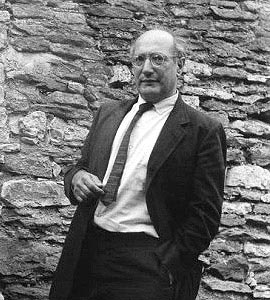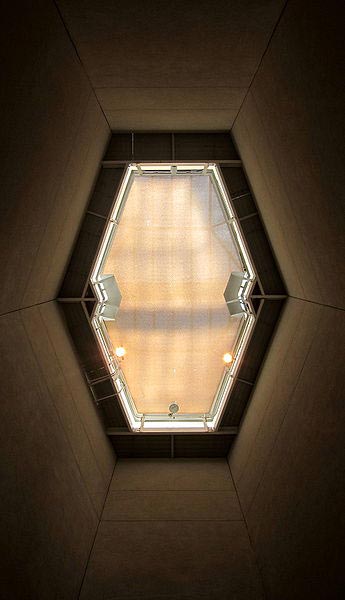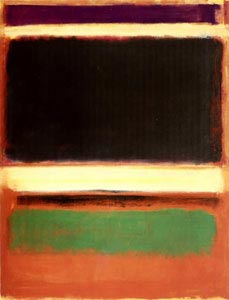| Mark Rothko | |
|---|---|
 |
|
| Photo by: Wikipedia Creative Commons | |
| Born | Sep. 25, 1903 Dvinsk, Vitebsk Province, Russian Empire (now Daugavpils, Latvia) |
| Died | Feb. 25, 1970 (at age 66) Manhattan, New York, United States |
| Nationality | Russian Empire American |
| Education | Yale (dropped out after 2 years) Grand Central School of Art (brief enrollment) Art Students League of New York (under tutelage of artist Max Weber) |
| Movement | Abstract Expressionism, Color Field |
| Field | Painting |
| Mark Rothko Famous Paintings | |
| White Center (Yellow, Pink and Lavender on Rose), 1950 | |
| Four Darks in Red, 1958 | |
| Untitled (Black on Grey), 1970 | |
| No. 3/No. 13 (Magenta, Black, Green on Orange), 1949 | |
| Orange, Red, Yellow, 1961 | |
| Black on Maroon, 1958 | |
| Complete Works |
Mark Rothko (September 25, 1903 – February 25, 1970) was an American citizen that travelled back to the United States from Russia in 1913. His family was based in Portland, Oregon and his childhood was filled with the issues of the society and politics that had been occurring at the time. He was a smart young fellow and was accepted into Yale University in 1921 with the dreams of becoming a labor leader. Unfortunately, his dreams were cut short when he dropped out from the university two years after he entered when he decided to explore the country. After several years he decided to settle in New York City. Living in a city filled with bustling artists and passion for the arts must have had a drastic effect on him, since he decided to take up painting. Rothko was mostly self-taught but he was also able to study under the tutelage of Max Weber. He would later be known for his works that established the contemplation of introspection into the school of thought: melodramatic post-World War II Abstract Expressionism. His bold utilization of color to express his ideas paved the way to the creation and development of the Color Field Painting.
Initially, he worked in a realistic style that was evident in his early work, a series of paintings entitled Subway series created in the 1930’s that showed the forlorn emotion set in a dreary urban surrounding. This artistic was what inspired the creation of the Baptismal Scene of 1945 which was ritualistic in nature that had semi-abstract bi-morphic forms. Around 1948, 3 years after the Baptismal Scene, he was able to achieve his own individual form of the genre, Abstract Expressionism. In contrast with most artists of the same genre, he did not make use of the conventional theatrical or vivid mannerisms such as paint splattering or violent brushstrokes. As an alternative, he opt to utilize the method of placing huge amounts of adjacent colors which he melted resulting in a work of art that looked as if the colors were afloat parallel to the plane of the picture in an almost indefinite space. In his later years, he spent a huge amount of his time devoted to continuously purifying this basic method. One way was to limit the use of images in his canvas to about two or three “soft-edged” rectangles that were vertically placed, that occupied the length of an entire wall.
Though massive in size, his works did not fail to convey a feeling of familiarity which was successfully done with the brilliant use of colors. Rothko had kept himself busy by working on several canvases, fourteen to be exact, from the year 1958 until 1966. The greatest in size was approximately 3.5 meters or 11.15 feet. This painting was hung in a nondenominational chapel located in Houston, Texas which was named renamed after the artist when he committed suicide in 1970. The series had a distinct monochromatic feel to it, having mostly the colors brown, maroon, red and black that deeply reflected the artist’s life nearing his death. His suicide in February 25, 1970 was believed to be due to his failing health conditions and the strong belief that his fame and his reputation had been forgotten by the society and those he taught during his prime.
As faith would have had it, his painting became a sensation after his passing, starting one of the most brilliant and multifaceted court cases in the history of modern art that dragged on for more than a decade (1972-1982). It was discovered that the artist had kept copious number of his artworks summing up to 798 paintings including several sketch works and drawings. The daughter of the departed artist, Kate Rothko, had indicted the executors of his father’s estate, Bernard J. Reis, Morton Levine, Theodoros Stamos and Frank Lloyd. The latter being the owner of New York’s Marlborough Galleries. They were charged with conspiracy and conflict of interest, marketing Rothko’s works for their own financial gain. Finally, after eleven years of waiting, the courts ruled in favour of Kate Rothko and held the executors accountable and were sentenced to pay a substantial amount for the damages. In the years when the trial was ongoing, a new board for the Mark Rothko Foundation had been created while the 798 works of the artist were divided among his two children and the Foundation. In 1984, the Foundation decided to allocate their share of the paintings to nineteen museums in several countries namely, Great Britain, United States, The Netherlands, Denmark and Israel. Amongst all, majority of the works had been placed at Washington, D.C in the National Gallery of Art.
Rothko had lived a life of a true artist. He did not allow the rules and techniques of his time hinder his creative spirit. He ventured into the unknown to refine his methods. Even in his own genre, Abstract Expressionism he made his own mark. Unafraid of being different or unique from artists of his time, he gave way to the development of something as significant as the Color Field Painting. Truly, Rothko is one great artist!

